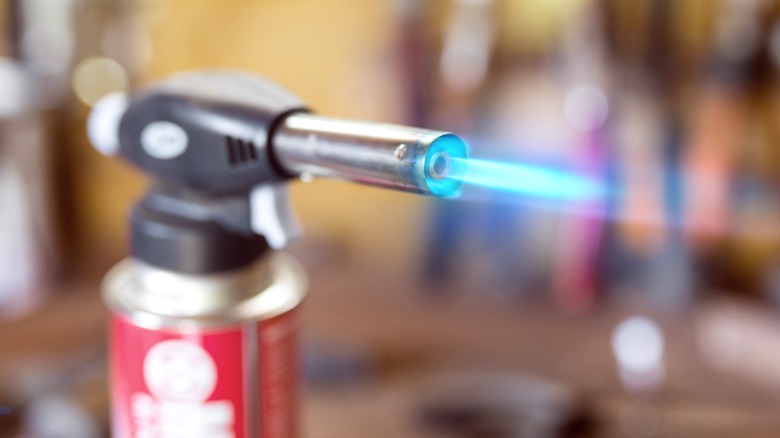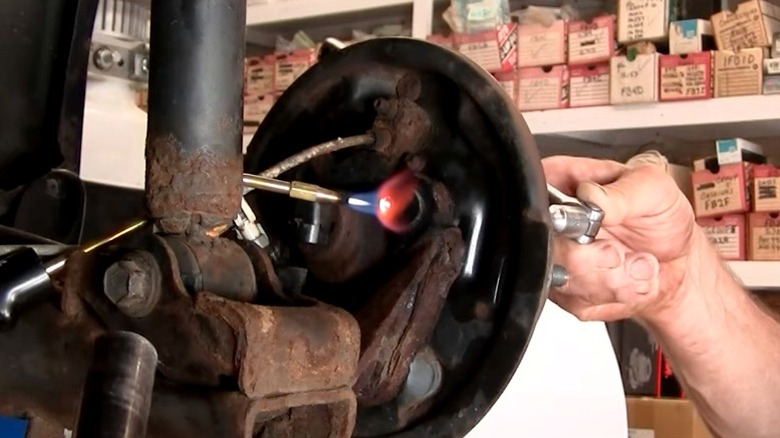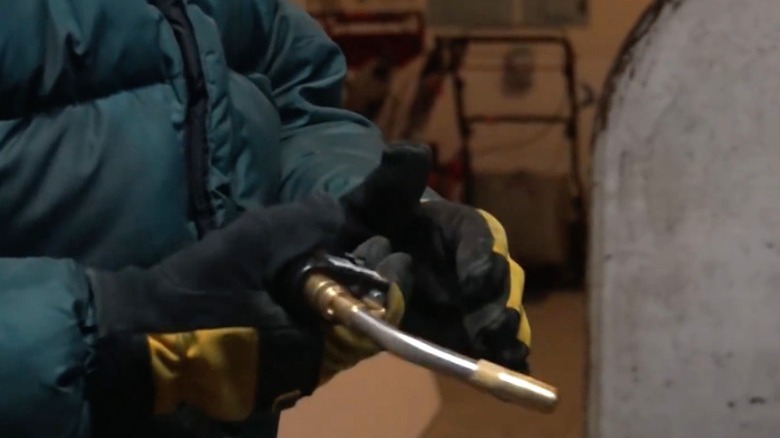Blast Stubborn Nuts And Bolts With A Torch And Watch What Happens
Rusted bolts are a fact of life when age takes its toll on cars, furniture, and various metal components, often putting you in a tight spot when you need to press on with a cleaning or repair project. Wrenches won't work no matter how much force you exert against a finicky fastener, and even lubricants may not get deep enough to make any meaningful gains on extra-tough rusted hardware. Where do you go from there? A nut splitter can be a crucial help in countless situations and a helpful tool for dealing with stubborn rusted bolts when they're a common issue. Still, it's hardly a staple in the average DIYer's tool kit. For a more immediate (and cheaper) alternative solution, this may be the right time to reach for an unexpected fix — a blowtorch!
Heating a rusted bolt may not be possible in every situation, but when it is, it can make quick work of loosening the metal pieces enough to bust them loose. As you apply high heat via a butane, propane, or, better still, MAPP torch, the metal will expand and break the corroded bonds enough for you to jar the bolt from the nut. With the fastener heated, you can try to break it loose with your socket wrench, impact wrench, or hammer. It's quick and simple if you're comfortable using a blowtorch and highly effective when you follow the proper process and safety guidelines.
How to remove stubborn nuts and bolts with a torch
Before you attempt to remove a rusty nut and bolt with your blowtorch, prep the setup for smoother results. Scrub away as much dirt, rust, and grime as possible with a wire brush. Apply a penetrating oil, like WD-40 or PB Blaster, to the nut and bolt. Let it flow into the connection for about 10 to 15 minutes, and clean any excess oil from the bolt with a rag.
Heat the bolt with your torch, moving the flame evenly over the nut to make it expand. Continue this for about 15 to 30 seconds. Tap the nut with your hammer to try to break the rust. You can also apply lubricant to the heated bolt, allowing it to flow between the freshly loosened threads. If you don't have any lubricant, you can also apply candle wax to help relieve the bond.
Try to break the nut loose with a wrench. If it still doesn't budge, repeat the process, heating it a bit more and tapping it with your hammer to get the bolt to break free. After heating, you can also try shocking the bolt with a blast of cool water, causing it to contract quickly and, hopefully, break the corroded connection further. From there, you can consider a few different ways to prevent metal from rusting to avoid having to use a blowtorch or any other alternative solution when you have to remove an old bolt later on.
Safety considerations when using a torch on rusted bolts
A blowtorch might be one of the best tools for removing rusty bolts without a nut splitter, but it's also one of the more dangerous. For safety, always reference the manufacturer's instructions before using your blowtorch. Look for damage around any seals or wear on the torch that may indicate leaks, and listen for any sounds of gas escaping.
If the canister and mechanism are in good condition, check for flammable or delicate materials, like rubber gaskets, around the work area before using the torch. Consider using a heat shield to protect items you can't remove. Likewise, you must look at the warnings on your lubricants and follow them accordingly. Some penetrating oils, such as WD-40, will ignite readily in their aerosol form, so avoid spraying it around an open flame. Keep a fire extinguisher nearby for emergencies. If working indoors, ensure you maintain quality ventilation. Rusty flecks may also fall away as you heat the bolt, so wear protective gloves, clothing, and eyewear when working. Account for these simple safety standards when using a blowtorch, and you can remove even the toughest rusted bolts with ease and confidence.


